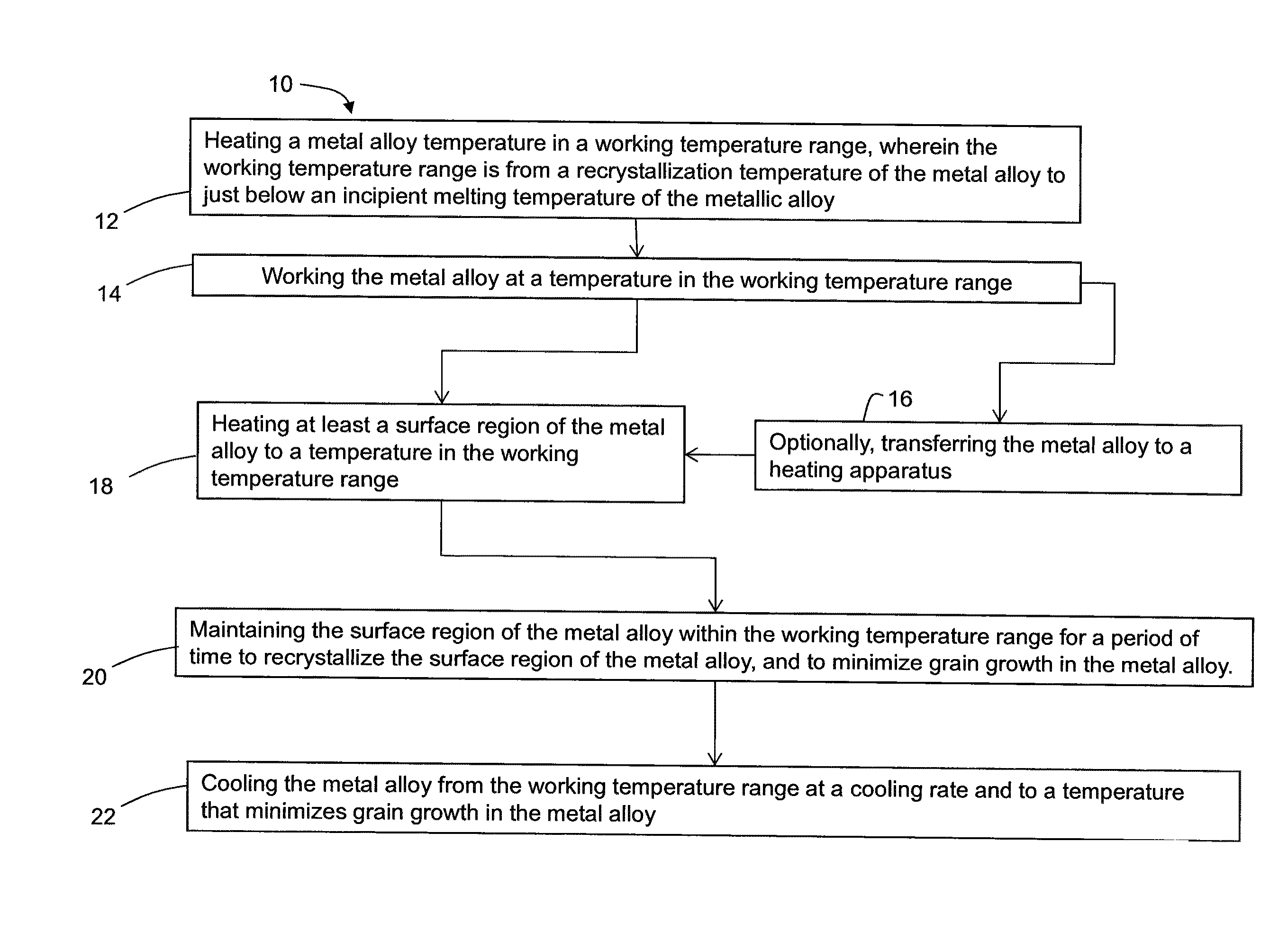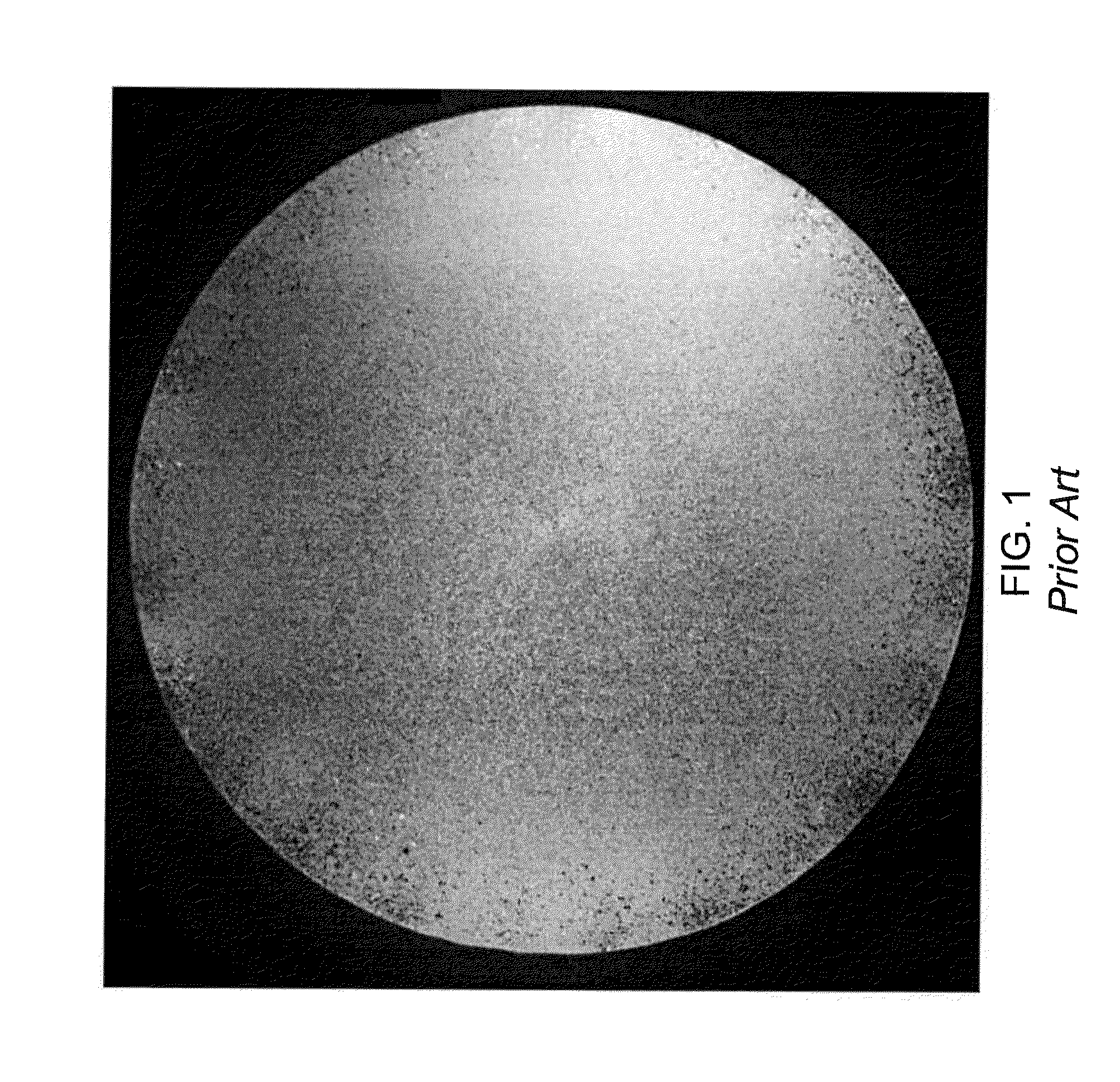Methods for processing metal alloys
a metal alloy and thermomechanical technology, applied in the direction of metal-working apparatuses, etc., can solve the problems of reducing the usefulness of such testing, reducing the alloy's high cycle fatigue resistance, and reducing the grain growth rate of the alloy surface, so as to minimize grain growth and minimize grain growth
- Summary
- Abstract
- Description
- Claims
- Application Information
AI Technical Summary
Benefits of technology
Problems solved by technology
Method used
Image
Examples
example 1
[0060]A 20 inch diameter ingot of Datalloy HP™ alloy, available from ATI Allvac, was prepared using a conventional melting technique combining argon oxygen decarburization and electroslag remelting steps. The ingot had the following measured chemistry, in weight percent based on total alloy weight: 0.007 carbon; 4.38 manganese; 0.015 phosphorus; less than 0.0003 sulfur; 0.272 silicon; 21.7 chromium; 30.11 nickel; 5.23 molybdenum; 1.17 copper; balance iron and unmeasured incidental impurities. The ingot was homogenized at 2200° F. and upset and drawn with multiple reheats on an open die press forge to a 12.5 inch diameter billet. The forged billet was further processed by the following steps which may be followed by reference to FIG. 6. The 12.5 inch diameter billet was heated (see, for example, FIG. 5, step 52) to an intermetallic phase precipitate dissolution temperature of 2200° F., which is a temperature in the intermetallic phase precipitate dissolution temperature range accordi...
example 2
[0061]A 20 inch diameter ingot of Datalloy HP™ alloy, available from ATI Allvac, was prepared using a conventional melting technique combining argon oxygen decarburization and electroslag remelting steps. The ingot had the following measured chemistry, in weight percent based on total alloy weight: 0.006 carbon; 4.39 manganese; 0.015 phosphorus; 0.0004 sulfur; 0.272 silicon; 21.65 chromium; 30.01 nickel; 5.24 molybdenum; 1.17 copper; balance iron and unmeasured incidental impurities. The ingot was homogenized at 2200° F. and upset and drawn with multiple reheats on an open die press forge to a 12.5 inch diameter billet. The billet was subjected to the following process steps, which may be followed by reference to FIG. 7. The 12.5 inch diameter billet was heated (see, for example, FIG. 5, step 52) to 2100° F., which is a temperature in the intermetallic phase precipitate dissolution temperature range according to the present disclosure, and maintained (53) at temperature for greater ...
example 3
[0062]A 20 inch diameter ingot of ATI Allvac AL-6XN® austenitic stainless steel alloy (UNS N08367) is prepared using a conventional melting technique combining argon oxygen decarburization and electroslag remelting steps. The ingot has the following measured chemistry, in weight percent based on total alloy weight: 0.02 carbon; 0.30 manganese; 0.020 phosphorus; 0.001 sulfur; 0.35 silicon; 21.8 chromium; 25.3 nickel; 6.7 molybdenum; 0.24 nitrogen; 0.2 copper; balance iron and other incidental impurities. The following process steps may be better understood with reference to FIG. 6. The ingot is heated (52) to 2300° F., which is a temperature in the intermetallic phase precipitate dissolution temperature range according to the present disclosure, and maintained (53) at temperature for 60 minutes to solutionize any sigma-phase intermetallic precipitates. The ingot is cooled to 2200° F., which is a temperature in a working temperature range, and then hot rolled (54) to 1 inch thick plat...
PUM
| Property | Measurement | Unit |
|---|---|---|
| Time | aaaaa | aaaaa |
| Temperature | aaaaa | aaaaa |
| Melting point | aaaaa | aaaaa |
Abstract
Description
Claims
Application Information
 Login to View More
Login to View More - R&D
- Intellectual Property
- Life Sciences
- Materials
- Tech Scout
- Unparalleled Data Quality
- Higher Quality Content
- 60% Fewer Hallucinations
Browse by: Latest US Patents, China's latest patents, Technical Efficacy Thesaurus, Application Domain, Technology Topic, Popular Technical Reports.
© 2025 PatSnap. All rights reserved.Legal|Privacy policy|Modern Slavery Act Transparency Statement|Sitemap|About US| Contact US: help@patsnap.com



